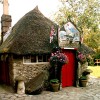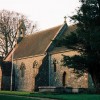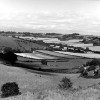About four miles west of Dorchester is the parish of Winterbourne Steepleton, its 1,800 acres laid out in a rectangular plan across the wooded valley of South Winterborne. The village is the original and only settlement in the parish and is found beside the River Winterbourne, which starts its journey in the neighbouring parish of Winterbourne Abbas. The several thatched cottages in the village date from the 16th, 17th and 18th centuries; throughout the parish there are prehistoric burial barrows, not uncommon in this area west of the county town.
The walls of the parish church, dedicated to St. Michael, are built mostly from Portland rubble with some Ham Hill dressings; the roofs are slate covered. The quoins at three corners of the nave have survived from the church that was here in Saxon times. The nave was rebuilt in the 12th century and there are fragments of wall paintings on the north wall. There is a blocked-up Norman doorway and a Norman west window that now looks into the tower; this was added in the 14th century and houses one late medieval bell. The south porch is also of the 14th century. Although the chancel was rebuilt during the 15th century, the chancel arch was not rebuilt until the 18th century and Hutchins tells us of a 15th century North Chapel that was demolished in 1688. There is a west gallery that bears the date 1708.
The Altar in the chancel is of the 12th or 13th century and has five consecration crosses. The font has a circular Bath Stone bowl with cable ornament at top, moulded arcade of segmental arches below; springing, alternately, from shafted pilasters and corbels of the late 12th century with a stem of Purbeck marble, cylindrical with four shafts and moulded base on square plinth of the 13th century. The modern pulpit has Jacobean panelling.
Of special interest and the churches greatest treasure is a sculpture of an archangel having his waist bound with chains and looking back at his flowing garments; his feet are raised as he flies along and he appears to be holding a skull in his hands. This is an ancient figure of the Archangel Michael and is similar to the angel in the Saxon church at Bradford-on-Avon. Pevsner dates this to the 10th century and says it would have been one of a pair but the RCHM has it from the first half of the 11th century.
The Mill and Millhouse are close to the church and are of the 17th century, though rebuilt and extended in the 18th century. The Manor House is not as old as it appears. It was built about 1870 on the site of a former house that belonged to the Lawrence family and nearby is Manor Cottage. This charming thatched property was built in the 16th century.
In the autumn of 2007 scaffolding went up around the medieval spire of St. Michael’s church; an inspection of the spire found the top seven courses of stonework would have to be removed and re-laid. The cost was a heavy burden on a small parish but with some grant aid including £6,000 from the Dorset Historic Churches Trust the money needed for the repairs was raised and the work completed in 2008.



